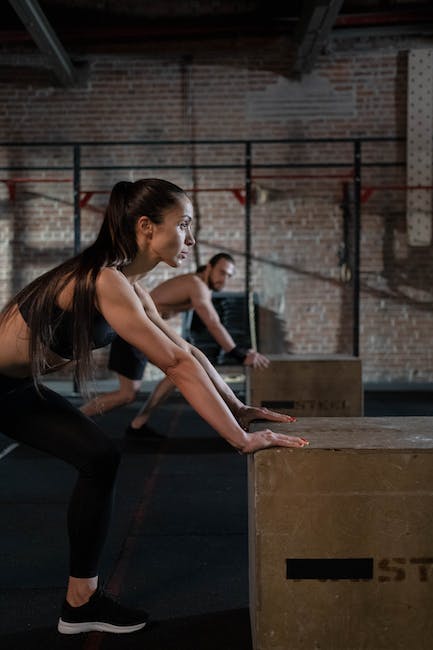Ladies and gentlemen, it’s time to put those boring treadmill runs to shame and shake things up with some explosive plyometric training! If you’re ready to take your fitness game to the next level and unleash your inner athlete, then listen up. Plyometrics are not just for hardcore athletes and superheroes-in-training. They bring a whole new level of fun, challenge, and results to your workouts. So put on your sneakers, warm up those muscles, and get ready to blast off like a rocketship! We promise, you won’t regret it.

Contents
- 1 1. Introduction: Understanding Plyometric Training and Its Benefits
- 2 2. Explosive Exercises: A Closer Look at Plyometric Training
- 3 3. How Plyometric Training Enhances Your Fitness and Athletic Performance
- 4 4. Key Considerations for Safe and Effective Plyometric Training
- 5 5. Incorporating Plyometric Exercises into Your Workout Routine
- 6 Jump into Your Training
1. Introduction: Understanding Plyometric Training and Its Benefits
Plyometric training? Sounds fancy and expensive, but it’s not. Plyometrics is a training technique that involves explosive movements such as jumping and bounding. And it doesn’t require a fancy gym or equipment, you can do plyometrics exercises anywhere, even in your backyard.
But wait, what are the benefits? Well, besides feeling like a superhero, plyometrics can help increase your power, explosiveness, and speed. It’s like developing a superpower to run and jump like an Olympic athlete without the annoying wait for the next Olympic games.
However, plyometric training is not for the faint of heart. You need to have a good level of strength and fitness before venturing into the world of plyometrics. Plus, it’s important to learn proper technique to avoid injury. Think of it like learning how to use your powers responsibly; you don’t want to fly into a wall or jump into traffic.

2. Explosive Exercises: A Closer Look at Plyometric Training
Are you ready to explode your workout routine? Look no further than plyometric training. This explosive style of exercise involves rapid movement and high-intensity jumps, all designed to boost your power and agility. But before you start bounding like a rabbit on steroids, let’s take a closer look at the world of plyometrics.
First up, we’ve got the classic move: the box jump. This simple exercise involves jumping up onto a box or platform, then jumping back down to the ground. It may sound easy, but once you start piling on the height, your thighs will be screaming for mercy. But fear not! With enough practice, you’ll be bounding up those boxes like a flea on a trampoline.
Next, let’s talk about the burpee. Ah yes, the dreaded burpee. This full-body move involves a series of quick jumps, squats, and push-ups that will leave you gasping for air by the end. But the beauty of the burpee is in its versatility – you can modify it to suit any fitness level, from beginner to ninja warrior. So whether you’re just starting out or looking to improve your explosive power, the burpee is a must-try move.
Last but not least, we have the jump squat. This move is like a regular squat, but with an added explosive jump at the top. It’s a fantastic way to build lower body strength and power, and it’s also great for improving your balance and coordination. So next time you’re feeling bored with your usual leg day routine, throw in some jump squats and watch the gains come rolling in.
So there you have it, folks. A closer look at the world of plyometric training. Whether you’re a seasoned gym-goer or a newbie in need of a challenge, these explosive exercises are sure to take your workout to the next level. Just remember to take it slow, stay safe, and always stretch before jumping in (see what we did there?).
3. How Plyometric Training Enhances Your Fitness and Athletic Performance
Plyometric training is the secret weapon that athletes of all levels use to enhance their speed, strength, and agility. This explosive form of exercise involves quick, powerful movements that produce high levels of energy output. It’s like doing cardio while drinking a gallon of Red Bull. Here are some of the ways that plyometric training can take your fitness and athletic performance to the next level.
– Plyometric exercises help activate fast-twitch muscle fibers, which are responsible for generating quick bursts of power. These fibers are like the cheetahs of the muscle world, capable of lightning-fast movements. So, if you want to run faster, jump higher, or punch harder, you need to train those fast-twitch fibers. Plyometrics is the way to do it.
– By performing plyometric exercises, you can improve your balance and coordination. Think about it: when you jump onto a box or do a bounding drill, you have to land and stabilize your body in a split second. This requires a high level of neuromuscular control, which translates to better overall movement quality. Plus, being able to balance on one foot while doing a single-leg jump is a great party trick.
– Plyometric training is a fantastic way to build cardiovascular endurance without running a marathon. Because you’re performing explosive movements with short rest periods, your heart rate stays elevated throughout the workout. This leads to increased oxygen uptake, better circulation, and improved overall cardiovascular fitness. Plus, since you’re not running 26.2 miles, you’ll have plenty of time to binge-watch Netflix afterwards.
So, there you have it. Plyometric training is not just for high-level athletes or people trying to impress their Instagram followers. It’s a fun and effective way to enhance your fitness and athleticism, no matter what your level of experience. Just make sure you have a good pair of sneakers, plenty of water, and an audience to watch you show off your new plyo skills.
4. Key Considerations for Safe and Effective Plyometric Training
So, you’re planning to start with plyometric training. Great move, but hold on! Before you start jumping around, there are a few key considerations that can make your training safe and effective.
First things first, don’t jump into plyometric training if you’re unprepared. Start off with some basic strength training to build a good foundation. You don’t want to end up with an injury before you’ve even started the real deal. A few sets of squats, lunges, and push-ups should do the trick.
Secondly, choose a suitable surface to perform plyometric exercises. Concrete or asphalt is a no-go. Stick to grass or rubberized surfaces to avoid impact-related injuries. Better safe than sorry, right?
Lastly, it’s important to pay attention to your form. Performing plyometric exercises with poor form can result in injury or wonky-looking jumps that are not Instagram-worthy. Keep your core tight, land softly on the balls of your feet, and keep your knees in the same direction as your toes. Your body will thank you later! If you’re not sure about your form, don’t be afraid to ask for proper guidance from a trained professional.
Remember, taking the time to prepare and maintain proper form can make all the difference between a successful plyometric training session and a disastrous one. So, go ahead, jump your way to your dream body. Just make sure you do it with caution and style!
5. Incorporating Plyometric Exercises into Your Workout Routine
Not only are plyometrics an excellent way to develop explosive power, speed, and agility, but they’re also a lot of fun! There’s nothing quite like jumping, hopping, and bounding your way through a workout.
But before you rush off to the gym to start your plyo journey, there are a few things you need to keep in mind. First, make sure you warm up properly before attempting any plyometric movements. I’m talking about a dynamic warm-up that includes movements that mimic the exercises you’ll be doing. This will help to prepare your muscles and joints and reduce the risk of injury.
- Tip: Incorporate some light cardio and mobility work such as jump rope, leg swings, and lunges to get your muscles ready.
Second, start with the basics. Don’t jump into advanced plyometric exercises right away. Begin with simple movements like box jumps, jump squats, and lateral jumps. As you become more comfortable with these basic movements, gradually increase the intensity and complexity of your exercises.
- Tip: Set realistic goals and track your progress to help you stay motivated.
Finally, make sure you give your body time to recover between plyometric workouts. These exercises are intense and put a lot of stress on your muscles and joints. Aim to do plyometrics no more than two to three times per week, and always listen to your body. If you’re feeling sore or fatigued, take a rest day.
- Tip: Incorporate some active recovery such as foam rolling or yoga to help ease muscle soreness and promote relaxation.
Jump into Your Training
Well, congratulations! You’ve just completed a crash course in plyometric training. You’re now fully equipped to take your fitness routine to explosive heights. Whether it’s box jumps or power skips, you know that every jump, hop, and skip will make you stronger and faster. Just remember to land softly, avoid overtraining, and watch out for that dreaded plyometric flu. Now, go ahead and jump your way to a fitter you!








Leave A Comment